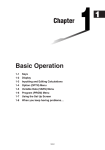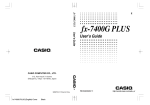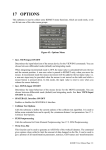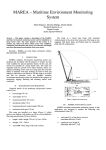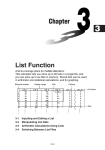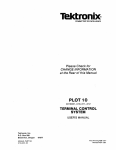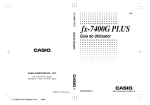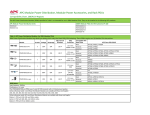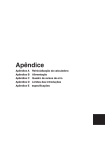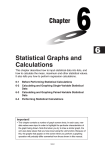Download Casio Algebra FX 2.0 Calculator
Transcript
Chapter
Programming
8-1
8-2
8-3
8-4
8-5
8-6
8-7
8-8
Basic Programming Steps
Program Mode Function Keys
Editing Program Contents
File Management
Command Reference
Using Calculator Functions in Programs
Program Mode Command List
Program Library
This unit comes with approximately 144 kbytes of memory.
• You can check how much memory has been used and how much remains
by entering the SYSTEM Mode from the Main Menu, and then pressing
1(Mem). See “9-2 Memory Operations” for details.
19990401
8
8-1-1
Basic Programming Steps
8-1 Basic Programming Steps
Description
Commands and calculations are executed sequentially, just like manual calculation
multistatements.
Set Up
1. From the Main Menu, enter the PRGM Mode. When you do, a program list appears on
the display.
Selected program area
(use f and c to move)
Files are listed in the alphabetic sequence of their
names.
Execution
2. Register a file name.
3. Input the program.
4. Run the program.
# If there are no programs stored in memory
when you enter the PRGM Mode, the
message “No Programs” appears on the
display and only the NEW item (3) is shown
in the function menu.
# The values to the right of the program list
indicate the number of bytes used by each
program.
# A file name can be up to eight characters
long.
# The following are the characters you can use in
a file name:
A through Z, r, θ, spaces, [, ], {, }, ’, ”, ~,
0 through 9, ., +, –, ×, ÷
# Registering a file name uses 24 bytes of
memory.
# The file name input screen remains on the
display if you press w without inputting a file
name.
# To exit the file name input screen and return to
the program list without registering a file name,
press i.
19990401
8-1-2
Basic Programming Steps
○ ○ ○ ○ ○
Example 1
To calculate the surface area (cm2) and volume (cm3) of three regular
octahedrons when the length of one side is 7, 10, and 15 cm
Store the calculation formula under the file name OCTA.
The following are the formulas used for calculating surface area S
and volume V of a regular octahedron for which the length of one side
A is known.
2
S = 2 3 A2, V = –––– A3
3
A
Procedure
1 m PRGM
2 3(NEW)OCTAw*1
3 !J(PRGM)3(?)aav(A)6(g)6(g)3(:)*2
c*!x(
!x(
)d*av(A)x6(g)4(^)
)c/d*av(A)Md
ii
4 1(EXE) or w
hw(Value of A)
w
S when A = 7
V when A = 7
w
wbaw
w
S when A = 10
V when A = 10
w
wbfw
w*3
S when A = 15
V when A = 15
* 1 Press 3(NEW) and the cursor changes form
to indicate alpha character input.
* 2 The following shows how the calculation of the
surface area and volume of a regular
octahedron would be calculated using a
manual calculation.
Surface Area S ... c*!x(
)d*
<value of A> xw
Volume V ............ !x(
)c/d*
<value of A> Mdw
*3 Pressing w while the final result of a program
is on the display changes to the program list.
# You can also run a program while in the RUN •
MAT Mode by inputting: Prog ”<file name>” w.
# Pressing w while the final result of a program
executed using this method is on the display
re-executes the program.
# An error occurs if the program specified by Prog
”<file name>” cannot be found.
19990401
8-2-1
Program Mode Function Keys
8-2 Program Mode Function Keys
• {NEW} ... {new program}
u When you are registering a file name
• {RUN}/{BASE} ... {general calculation}/{number base} program input
• {Q
Q} ... {password registration}
• {SYBL} ... {symbol menu}
u When you are inputting a program —— 1(RUN) … default
• {JUMP} ... {top}/{bottom} of program
• {SRC} ... {search}
• {MAT}/ {STAT}/{LIST}/{GRPH}/{DYNA}/{RECR}
... {matrix}/{statistic}/{list}/{graph}/ {Dynamic Graph}/{recursion} menu
• Pressing !J(PRGM) displays the following PRGM (PROGRAM) menu.
• {Prog} ... {program recall}
• {JUMP} ... {jump command menu}
• {?}/{^
^} ... {input}/{output} command
• {I/O} ... {I/O control/transfer command menu}
• {IF}/{FOR}/{WHLE}/{CTRL}/{LOGIC}
... {conditional jump}/{loop control}/{conditional loop control}/{program control}/
{logical operation} command menu
• {CLR}/{DISP} ... {clear}/{display} command menu
• {:} ......... {separator for expressions and commands}
See “8-5 Command Reference” for full details on each of these commands.
• Pressing u3(SET UP) displays the mode command menu shown below.
• {ANGL}/{DISP}/{CPLX}/{GRPH}/{STAT}/{DERIV}/{T-VAR}/{Σ DSP}
See “SET UP Screen Function Key Menus” on page 1-7-1 for details about each of these
commands.
19990401
8-2-2
Program Mode Function Keys
u When you are inputting a program —— 2(BASE)*1
• {JUMP}/{SRC}
• {d~o} ... {decimal}/{hexadecimal}/{binary}/{octal} value input
• {LOG} ... {logical operators}
• {DISP} ... conversion of displayed value to {decimal}/{hexadecimal}/{binary}/{octal}
• {SYBL} ... {symbol menu}
• Pressing !J(PRGM) displays the following PRGM (PROGRAM) menu.
• {Prog}/{JUMP}/{?}/{^
^}
• {= ≠ <} ... {logical operator menu}
• {:} ......... {separator for expressions and commands}
• Pressing u3(SET UP) displays the mode command menu shown below.
• {Dec}/{Hex}/{Bin}/{Oct}
• {EXE}/{EDIT}
... program {execute}/{edit}
• {NEW} ... {new program}
• {DEL}/{DEL·A}
... {specific program}/{all program} delete
• {SRC}/{REN}
... file name {search}/{change}
* 1 Programs input after pressing 2(BASE) are
indicated by B to the right of the file name.
19990401
8-3-1
Editing Program Contents
8-3 Editing Program Contents
k Debugging a Program
A problem in a program that keeps the program from running correctly is called a “bug,” and
the process of eliminating such problems is called “debugging.” Either of the following
symptoms indicates that your program contains bugs that require debugging.
• Error messages appearing when the program is run
• Results that are not within your expectations
u To eliminate bugs that cause error messages
An error message, like the one shown below, appears whenever something illegal occurs
during program execution.
When such a message appears, press i to display the place in the program where the error
was caused. The cursor will be flashing at the location of the problem. Check the “Error
Message Table” (page α-1-1) for steps you should take to correct the situation.
• Note that pressing i does not display the location of the error if the program is
password protected. Instead, it returns to the program list screen.
u To eliminate bugs that cause bad results
If your program produces results that are not what you normally expect, check the
contents of the program and make necessary changes.
The 1(JUMP) key is also useful when editing program contents.
1(JUMP)b(Top) ....... Moves the cursor to the
top of the program
1(JUMP)c(Bottom)… Moves the cursor to the
bottom of the program
19990401
8-3-2
Editing Program Contents
k Using an Existing Program to Create a New Program
Sometimes you can input a new program by using a program already in memory as a base.
Simply recall the existing program, make the changes you need, and then execute it.
○ ○ ○ ○ ○
Example 2
To use the OCTA program (page 8-1-2) to create a program that
calculates the surface area (cm2) and volume (cm3) of regular
tetrahedrons when the length of one side is 7, 10, and 15 cm
Use TETRA as the file name.
A
The following are the formulas used for calculating surface area S
and volume V of a regular tetrahedron for which the length of one
side A is known.
2
S = 3 A2, V = –––– A3
12
Use the following key operations when inputting the program.
Length of One Side A .. !J(PRGM)3(?)aav(A)6(g)6(g)3(:)
Surface Area S ............ !x(
)d*av(A)x6(g)4(^)
Volume V ..................... !x(
)c/bc*av(A)Md
Compare this with the program for calculating the surface area and volume of a regular
octahedron.
Length of One Side A .. !J(PRGM)3(?)aav(A)6(g)6(g)3(:)
Surface Area S ............ c*!x(
Volume V ..................... !x(
)d*av(A)x6(g)4(^)
)c/d*av(A)Md
As you can see, you can produce the TETRA program by making the following changes in
the OCTA program.
• Deleting c * (underlined using a wavy line above)
• Changing d to b c (underlined using a solid line above)
19990401
8-3-3
Editing Program Contents
Now edit OCTA to produce the TETRA program.
1. Edit the program name.
6(g)2(REN)ATETRAw
2. Edit the program contents.
2(EDIT)
eeeeDD
cdDbc
i
3. Try running the program.
1(EXE) or w
hw(Value of A)
w
w
wbaw
w
w
wbfw
w
19990401
8-3-4
Editing Program Contents
k Searching for Data Inside a Program
○ ○ ○ ○ ○
Example
To search for the letter “A” inside the program named OCTA
1. Recall the program.
2. Press 2(SRC) or w and input the data you want to find.
2(SRC)
av(A)
3. Press w to begin the search. The contents of the program appears on the screen with
the cursor located at the first instance of the data you specified.*1
4. Each press of w or 1(SRC) causes the cursor to
jump to the next instance of the data you specified.*2
* 1 The message “Not Found” appears when the
search data you specify cannot be found in
the program.
* 2 If there are no more instances of the data you
specified, the search operation ends and the
cursor returns to the point from which you
started your search.
# You cannot specify the newline symbol (_) or
display command (^) for the search data.
# Once the contents of the program are on the
screen, you can use the cursor keys to move
the cursor to another location before searching
for the next instance of the data. Only the part of
the program starting from the current cursor
location is searched when you press w.
# Once the search finds an instance of your data,
inputting characters or moving the cursor
causes the search operation to be cancelled.
# If you make a mistake while inputting characters
to search for, press A to clear your input and
re-input from the beginning.
19990401
8-4-1
File Management
8-4 File Management
k Searching for a File
u To find a file using initial character search
○ ○ ○ ○ ○
Example
To use initial character search to recall the program named OCTA
1. While the program list is on the display, press 6(g)1(SRC) and input the initial
characters of the file you want to find.
6(g)1(SRC)
OCT
2. Press w to search.
• The name that starts with the characters you input highlights.
# If there is no program whose file name starts
with the characters you input, the message
“Not Found” appears on the display. If this
happens, press i to clear the error message.
19990401
8-4-2
File Management
k Editing a file name
○ ○ ○ ○ ○
Example
To change the name of a file from TRIANGLE to ANGLE
1. While the program list is on the display, use f and c to move the highlighting to the
file whose name you want to edit and then press 6(g)2(REN).
2. Make any changes you want.
DDD
3. Press w to register the new name and return to the program list.
The program list is resorted according to the changes you made in the file name.
k Deleting a Program
u To delete a specific program
1. While the program list is on the display, use f and c to move the highlighting to the
name of the program you want to delete.
2. Press 4(DEL).
3. Press w(Yes) to delete the selected program or i(No) to abort the operation
without deleting anything.
# If the modifications you make result in a file
name that is identical to the name of a
program already stored in memory, the
message “Already Exists” appears. When this
happens, you can perform either of the
following two operations to correct the
situation.
• Press i to clear the error and return to the file
name editing screen.
• Press A to clear the input file name and input
a new one.
19990401
8-4-3
File Management
u To delete all programs
1. While the program list is on the display, press 5(DEL·A).
2. Press w(Yes) to delete all the programs in the list or i(No) to abort the operation
without deleting anything.
• You also can delete all programs by entering the SYSTEM Mode from the Main Menu, and
then pressing 1(Mem) to display the memory management screen.
See “9-2 Memory Operations” for details.
k Registering a password
When inputting a program, you can protect it with a password that limits access to the
program contents to those who know the password.
• You do not need to input the password to run a program.
○ ○ ○ ○ ○
Example
To create a program file under the name AREA and protect it with the
password CASIO
1. While the program list is on the display, press 3(NEW) and input the file name of the
new program file.
3(NEW)
AREA
2. Press 5(Q) and then input the password.
5(Q)
CASIO
# The password input procedure is identical to
that used for file name input.
19990401
8-4-4
File Management
3. Press w to register the file name and password. Now you can input the contents of
the program file.
4. After inputting the program, press !i(QUIT) to exit the program file and return to
the program list. Files that are password protected are indicated by an asterisk to the
right of the file name.
k Recalling a Password Protected Program
○ ○ ○ ○ ○
Example
To recall the file named AREA which is protected by the password
CASIO
1. In the program list, use f and c to move the highlighting to the name of the
program you want to recall.
2. Press 2(EDIT).
3. Input the password and press w to recall the program.
# Pressing w without inputting a password
while saving a new program causes the file to
be saved without a password. Pressing w
without inputting a password registers the file
name only, without a password.
# Inputting the wrong password when recalling a
password protected program causes the
message "Mismatch" to appear. Press i to
return to the password input screen.
19990401
8-5-1
Command Reference
8-5 Command Reference
k Command Index
Break ............................................................................................................... 8-5-6
ClrGraph ....................................................................................................... 8-5-11
ClrList ............................................................................................................ 8-5-11
ClrText ........................................................................................................... 8-5-12
ClrMat ............................................................................................................ 8-5-12
DispF-Tbl, DispR-Tbl ..................................................................................... 8-5-12
Do~LpWhile ..................................................................................................... 8-5-5
DrawDyna ..................................................................................................... 8-5-12
DrawFTG-Con, DrawFTG-Plt ........................................................................ 8-5-13
DrawGraph ................................................................................................... 8-5-13
DrawR-Con, DrawR-Plt ................................................................................. 8-5-13
DrawRΣ-Con, DrawRΣ-Plt ............................................................................. 8-5-14
DrawStat ....................................................................................................... 8-5-14
DrawWeb ....................................................................................................... 8-5-14
Dsz .................................................................................................................. 8-5-9
For~To~(Step~)Next ........................................................................................ 8-5-4
Getkey ........................................................................................................... 8-5-15
Goto~Lbl ....................................................................................................... 8-5-10
If~Then~(Else~)IfEnd ...................................................................................... 8-5-4
Isz .................................................................................................................. 8-5-11
Locate ............................................................................................................ 8-5-16
Prog ................................................................................................................ 8-5-7
Receive ( / Send ( .......................................................................................... 8-5-17
Return ............................................................................................................. 8-5-8
Stop ................................................................................................................ 8-5-8
While~WhileEnd .............................................................................................. 8-5-6
? (Input Command) ......................................................................................... 8-5-2
^ (Output Command) ..................................................................................... 8-5-3
: (Multi-statement Command) .......................................................................... 8-5-3
_ (Carriage Return) ....................................................................................... 8-5-3
’ (Comment Text Delimiter) .............................................................................. 8-5-3
=, G , >, <, ≥, ≤ (Relational Operators) ........................................................... 8-5-18
19990401
8-5-2
Command Reference
The following are conventions that are used in this section when describing the various
commands.
Boldface Text ............... Actual commands and other items that always must be
input are shown in boldface.
{Curly Brackets} ........... Curly brackets are used to enclose a number of items,
one of which must be selected when using a command.
Do not input the curly brackets when inputting a command.
[Square Brackets] ........ Square brackets are used to enclose items that are
optional. Do not input the square brackets when inputting
a command.
Numeric Expressions ... Numeric expressions (such as 10, 10 + 20, A) indicate
constants, calculations, numeric constants, etc.
Alpha Characters ......... Alpha characters indicate literal strings (such as AB).
k Basic Operation Commands
? (Input Command)
Function: Prompts for input of values for assignment to variables during program execution.
Syntax: ? → <variable name>, ”<prompt>” ? → <variable name>
Example: ? → A
Description:
• This command momentarily interrupts program execution and prompts for input of a value
or expression for assignment to a variable. If you do not specify a prompt, execution of this
command causes “?” to appear indicating the calculator is standing by for input. If a prompt
is specified, “<prompt>?” appears to prompt input. There is no limit to the number of
characters that can be specified for a prompt.
• Input in response to the input command must be a value or an expression, and the
expression cannot be a multi-statement.
19990401
8-5-3
Command Reference
^ (Output Command)
Function: Displays an intermediate result during program execution.
Description:
• This command momentarily interrupts program execution and displays alpha character text
or the result of the calculation immediately before the command.
• The output command should be used at locations where you would normally press the w
key during a manual calculation.
: (Multi-statement Command)
Function: Connects two statements for sequential execution without stopping.
Description:
• Unlike the output command (^), statements connected with the multi-statement command
are executed non-stop.
• The multi-statement command can be used to link two calculation expressions or two
commands.
• You can also use a carriage return indicated by _ in place of the multi-statement
command.
_ (Carriage Return)
Function: Connects two statements for sequential execution without stopping.
Description:
• Operation of the carriage return is identical to that of the multi-statement command.
• Using a carriage return in place of the multi-statement command makes the displayed
program easier to read.
’ (Comment Text Delimiter)
Function: Indicates comment text inserted inside a program.
Description: Anything following the apostrophe is treated as non-executable comment text.
19990401
8-5-4
Command Reference
k Program Commands (COM)
If~Then~(Else~)IfEnd
Function: The Then-statement is executed only when the If-condition is true
(non-zero). The Else-statement is executed when the If-condition is false (0). The IfEndstatement is always executed following either the Then-statement or Else-statement.
Syntax:
If
<condition>
numeric expression
_
:
^
_
:
^
Then <statement>
Else <statement>
_
:
^
_
:
^
<statement>
<statement>
_
:
^
IfEnd
Parameters: condition, numeric expression
Description:
(1) If ~ Then ~ IfEnd
• When the condition is true, execution proceeds with the Then-statement and then
continues with the statement following IfEnd.
• When the condition is false, execution jumps to the statement following IfEnd.
(2) If ~ Then ~ Else ~ IfEnd
• When the condition is true, execution proceeds with the Then-statement and then jumps
to the statement following IfEnd.
• When the condition is false, execution jumps to the Else-statement and then continues
with the statement following IfEnd.
For~To~(Step~)Next
Function: This command repeats everything between the For-statement and the Nextstatement. The starting value is assigned to the control variable with the first execution, and
the value of the control variable is changed according to the step value with each execution.
Execution continues until the value of the control variable exceeds the ending value.
Syntax:
For <starting value> → <control variable name> To <ending value> Step <step value>
Next
Parameters:
•
•
•
•
control variable name: A to Z
starting value: value or expression that produces a value (i.e. sin x, A, etc.)
ending value: value or expression that produces a value (i.e. sin x, A, etc.)
step value: numeric value (default: 1)
19990401
_
:
^
8-5-5
Command Reference
Description:
• The default step value is 1.
• Making the starting value less than the ending value and specifying a positive step value
causes the control variable to be incremented with each execution. Making the starting
value greater than the ending value and specifying a negative step value causes the
control variable to be decremented with each execution.
Do~LpWhile
Function: This command repeats specific commands as long as its condition is true (nonzero).
Syntax:
Do
_
:
^
<statement>
_
:
^
LpWhile
<condition>
numeric expression
Parameters: expression
Description:
• This command repeats the commands contained in the loop as long as its condition is true
(non-zero). When the condition becomes false (0), execution proceeds from the statement
following the LpWhile-statement.
• Since the condition comes after the LpWhile-statement, the condition is tested (checked)
after all of the commands inside the loop are executed.
19990401
8-5-6
Command Reference
While~WhileEnd
Function: This command repeats specific commands as long as its condition is true (nonzero).
Syntax:
While
<condition>
numeric expression
_
:
^
<statement>
_
:
^
WhileEnd
Parameters: expression
Description:
• This command repeats the commands contained in the loop as long as its condition is true
(non-zero). When the condition becomes false (0), execution proceeds from the statement
following the WhileEnd-statement.
• Since the condition comes after the While-statement, the condition is tested (checked)
before the commands inside the loop are executed.
k Program Control Commands (CTL)
Break
Function: This command breaks execution of a loop and continues from the next command
following the loop.
Syntax: Break
Description:
• This command breaks execution of a loop and continues from the next command following
the loop.
• This command can be used to break execution of a For-statement, Do-statement, and
While-statement.
19990401
8-5-7
Command Reference
Prog
Function: This command specifies execution of another program as a subroutine. In the
RUN • MAT Mode, this command executes a new program.
Syntax: Prog ”file name”
Example: Prog ”ABC”
Description:
• Even when this command is located inside of a loop, its execution immediately breaks the
loop and launches the subroutine.
• This command can be used as many times as necessary inside of a main routine to call up
independent subroutines to perform specific tasks.
• A subroutine can be used in multiple locations in the same main routine, or it can be called
up by any number of main routines.
Main Routine
A
Subroutines
D
Prog ”D”
Prog ”C”
C
E
Prog ”E”
Prog ”I”
Level 1
I
J
Prog ”J”
Level 2 Level 3
Level 4
• Calling up a subroutine causes it to be executed from the beginning. After execution of the
subroutine is complete, execution returns to the main routine, continuing from the statement following the Prog command.
• A Goto~Lbl command inside of a subroutine is valid inside of that subroutine only. It cannot
be used to jump to a label outside of the subroutine.
• If a subroutine with the file name specified by the Prog command does not exist, an error
occurs.
• In the RUN • MAT Mode, inputting the Prog command and pressing w launches the
program specified by the command.
19990401
8-5-8
Command Reference
Return
Function: This command returns from a subroutine.
Syntax: Return
Description:
Execution of the Return command inside a main routine causes execution of the program to
stop. Execution of the Return command within a subroutine terminates the subroutine and
returns to the program from which the subroutine was jumped to.
Stop
Function: This command terminates execution of a program.
Syntax: Stop
Description:
• This command terminates program execution.
• Execution of this command inside of a loop terminates program execution without an error
being generated.
19990401
8-5-9
Command Reference
k Jump Commands (JUMP)
Dsz
Function: This command is a count jump that decrements the value of a control variable by
1, and then jumps if the current value of the variable is zero.
Syntax:
Variable Value G 0
Dsz <variable name> : <statement>
Variable Value = 0
_
:
^
<statement>
Parameters: variable name: A to Z, r, θ
[Example] Dsz B : Decrements the value assigned to variable B by 1.
Description:
This command decrements the value of a control variable by 1, and then tests (checks) it. If
the current value is non-zero, execution continues with the next statement. If the current
value is zero, execution jumps to the statement following the multi-statement command (:),
display command (^), or carriage return (_).
19990401
8-5-10
Command Reference
Goto~Lbl
Function: This command performs an unconditional jump to a specified location.
Syntax: Goto <label name> ~ Lbl <label name>
Parameters: label name: value (0 to 9), variable (A to Z, r, θ )
Description:
• This command consists of two parts: Goto n (where n is a parameter as described above)
and Lbl n (where n is the parameter referenced by Goto n). This command causes program
execution to jump to the Lbl-statement whose n parameter matches that specified by the
Goto-statement.
• This command can be used to loop back to the beginning of a program or to jump to any
location within the program.
• This command can be used in combination with conditional jumps and count jumps.
• If there is no Lbl-statement whose value matches that specified by the Goto-statement, an
error occurs.
19990401
8-5-11
Command Reference
Isz
Function: This command is a count jump that increments the value of a control variable by
1, and then jumps if the current value of the variable is zero.
Syntax:
Variable Value G 0
Isz <variable name> : <statement>
_
:
<statement>
^
Variable Value = 0
Parameters: variable name: A to Z, r, θ
[Example] Isz A : Increments the value assigned to variable A by 1.
Description:
This command increments the value of a control variable by 1, and then tests (checks) it. If
the current value is non-zero, execution continues with the next statement. If the current
value is zero, execution jumps to the statement following the multi-statement command (:),
display command (^), or carriage return (_).
k Clear Commands (CLR)
ClrGraph
Function: This command clears the graph screen and returns View Windows settings to
their INIT values.
Syntax: ClrGraph
Description: This command clears the graph screen during program execution.
ClrList
Function: This command deletes list data.
Syntax: ClrList <list name>
ClrList
Parameters: list name: 1 to 20, Ans
Description: This command deletes the data in the list specified by “list name”. All list data is
deleted if nothing is specified for “list name”.
19990401
8-5-12
Command Reference
ClrText
Function: This command clears the text screen.
Syntax: ClrText
Description: This command clears text from the screen during program execution.
ClrMat
Function: This command deletes matrix data.
Syntax: ClrMat <matrix name>
ClrMat
Parameters: matrix name: A to Z, Ans
Description: This command deletes the data in the matrix specified by “matrix name”. All
matrix data is deleted if nothing is specified for “matrix name”.
k Display Commands (DISP)
DispF-Tbl, DispR-Tbl
No parameters
Function: These commands display numeric tables.
Description:
• These commands generate numeric tables during program execution in accordance with
conditions defined within the program.
• DispF-Tbl generates a function table, while DispR-Tbl generates a recursion table.
DrawDyna
No parameters
Function: This command executes a Dynamic Graph draw operation.
Description: This command draws a Dynamic Graph during program execution in
accordance with current Dynamic Graph parameters.
19990401
8-5-13
Command Reference
DrawFTG-Con, DrawFTG-Plt
No parameters
Function: This command uses values in a generated table to graph a function.
Description:
• This command draws a function graph in accordance with current conditions.
• DrawFTG-Con produces a connect type graph, while DrawFTG-Plt produces a plot type
graph.
DrawGraph
No parameters
Function: This command draws a graph.
Description:
• This command draws a graph in accordance with current conditions.
DrawR-Con, DrawR-Plt
No parameters
Function: These commands use values in a generated table to graph a recursion
expression with an (bn or cn ) as the vertical axis and n as the horizontal axis.
Description:
• These commands graph recursion expressions in accordance with current conditions, with
an (bn or cn) as the vertical axis and n as the horizontal axis.
• DrawR-Con produces a connect type graph, while DrawR-Plt produces a plot type graph.
19990401
8-5-14
Command Reference
DrawRΣ-Con, DrawRΣ-Plt
No parameters
Function: These commands use values in a generated table to graph a recursion
expression with Σan(Σbn or Σ cn) as the vertical axis and n as the horizontal axis.
Description:
• These commands graph recursion expressions in accordance with current conditions, with
Σan(Σbn or Σcn) as the vertical axis and n as the horizontal axis.
• DrawRΣ-Con produces a connect type graph, while DrawRΣ-Plt produces a plot type graph.
DrawStat
Function: This draws a statistical graph.
Syntax: See “8-6-9 Using Statistical Calculations and Graphs in a Program”.
Description:
This command draws a statistical graph in accordance with current statistical graph
conditions.
DrawWeb
Function: This command graphs convergence/divergence of a recursion expression (WEB
graph).
Syntax: DrawWeb <recursion type>, <number of lines>
Example: DrawWeb an+1 (bn+1 or cn+1), 5
Description:
• This command graphs convergence/divergence of a recursion expression (WEB graph).
• Omitting the number of lines specification automatically specifies the default value 30.
19990401
8-5-15
Command Reference
k Input/Output Commands (I/O)
Getkey
Function: This command returns the code that corresponds to the last key pressed.
Syntax: Getkey
Description:
• This command returns the code that corresponds to the last key pressed.
79
69
59
49
78
68
58
48
39
29
28
38
27
77
67
57
47
76
66
56
46
36
26
75
65
55
45
35
25
37
74
64
54
44
73
63
53
43
33
72
62
52
42
32
71
61
51
41
31
• A value of zero is returned if no key was pressed previous to executing this command.
• This command can be used inside of a loop.
19990401
8-5-16
Command Reference
Locate
Function: This command displays alpha-numeric characters at a specific location on the text
screen.
Syntax: Locate <column number>, <line number>, <value>
Locate <column number>, <line number>, <numeric expression>
Locate <column number>, <line number>, ”<string>”
[Example] Locate 1, 1, ”AB”_
Parameters:
•
•
•
•
line number: number from 1 to 7
column number: number from 1 to 21
value and numeric expression
string: character string
Description:
• This command displays values (including variable contents) or text at a specific location on
the text screen. If there is a calculation input, that calculation result is displayed.
• The row is designated by a value from 1 to 7, which the column is designed by a value
from 1 to 21.
(1, 1) →
← (21, 1)
(1, 7) →
← (21, 7)
Example: Cls_
Locate 7, 1, ”CASIO FX”
This program displays the text “CASIO FX” in the center of the screen.
• In some cases, the ClrText command should be executed before running the above program.
19990401
8-5-17
Command Reference
Receive ( / Send (
Function: This command receives data from and sends data to a connected device.
Syntax: Receive (<data>) / Send (<data>)
Description:
• This command receives data from and sends data to a connected device.
• The following types of data can be received (sent) by this command.
• Individual values assigned to variables
• Matrix data (all values - individual values cannot be specified)
• List data (all values - individual values cannot be specified)
19990401
8-5-18
Command Reference
k Conditional Jump Relational Operators (REL)
=, G, >, <, ≥, ≤
Function: These relational operators are used in combination with the conditional jump
command.
Syntax:
<left side> <relational operator> <right side>
Parameters:
left side/right side: variable (A to Z, r, θ ), numeric constant, variable expression (such as: A ×
2)
relational operator: =, G , >, <, ≥, ≤
19990401
8-6-1
Using Calculator Functions in Programs
8-6 Using Calculator Functions in Programs
k Text Display
You can include text in a program by simply enclosing it between double quotation marks.
Such text appears on the display during program execution, which means you can add labels
to input prompts and results.
Program
Display
”CASIO”
CASIO
?→X
?
”X =” ? → X
X=?
• If the text is followed by a calculation formula, be sure to insert a display command (^)
between the text and calculation.
• Inputting more than 21 characters causes the text to move down to the next line. The
screen scrolls automatically if the text causes the screen to become full.
k Using Matrix Row Operations in a Program
These commands let you manipulate the rows of a matrix in a program.
• For this program, enter the RUN • MAT Mode and then use the MAT Editor to input the
matrix, and then enter the PRGM Mode to input the program.
u To swap the contents of two rows (Swap)
○ ○ ○ ○ ○
Example 1
To swap the values of Row 2 and Row 3 in the following matrix:
1 2
Matrix A =
3
4
5
6
The following is the syntax to use for this program.
Swap A, 2, 3_
Rows to be swapped
Matrix name
Mat A
Executing this program produces the following result.
19990401
8-6-2
Using Calculator Functions in Programs
`Row)
u To calculate a scalar product (`
○ ○ ○ ○ ○
Example 2
To calculate the scalar product of Row 2 of the matrix in Example 1,
multiplying by 4
The following is the syntax to use for this program.
`Row 4, A, 2_
Row
Matrix name
Multiplier
Mat A
Executing this program produces the following result.
` Row+)
u To calculate a scalar product and add the results to another row (`
○ ○ ○ ○ ○
Example 3
To calculate the scalar product of Row 2 of the matrix in Example 1,
multiplying by 4, and add the result to row 3
The following is the syntax to use for this program.
`Row+ 4, A, 2, 3_
Rows to be added
Row for which scalar product is to be calculated.
Matrix name
Multiplier
Mat A
Executing this program produces the following result.
19990401
8-6-3
Using Calculator Functions in Programs
u To add two rows (Row+)
○ ○ ○ ○ ○
Example 4
To add Row 2 to Row 3 of the matrix in Example 1
The following is the syntax to use for this program.
Row+ A, 2, 3_
Rows to be added
Row for which scalar product is to be calculated.
Matrix name
Mat A
Executing this program produces the following result.
k Using Graph Functions in a Program
You can incorporate graph functions into a program to draw complex graphs and to overlay
graphs on top of each other. The following shows various types of syntax you need to use when
programming with graph functions.
• View Window
View Window –5, 5, 1, –5, 5, 1_
• Graph function input
Y = Type_ ..................... Specifies graph type.
”X2 – 3” → Y1_
• Graph draw operation
DrawGraph_
Example Program
1
ClrGraph_
1
!J661ci
2
View Window –10, 10, 2, –120, 150, 50_
2
!K1i
3
Y = Type_
3
61db
”X^4– X^3– 24X2 + 4X + 80” @ Y1_
4
J4bi
61b
!J662c
4
5
G SelOn 1_
5
6
DrawGraph
6
Executing this program produces the result
shown here.
19990401
8-6-4
Using Calculator Functions in Programs
u Syntax of other graphing functions
• V-Window
View Window <Xmin>, <Xmax>, <Xscale>, <Ymin>, <Ymax>, <Yscale>,
<Tθ min>, <Tθ max>, <T θ pitch>
StoV-Win <area of V-Win> .............. area: 1 to 6
RclV-Win <area of V-Win> .............. area: 1 to 6
• Zoom
Factor <X factor>, <Y factor>
ZoomAuto ........... Non-parameter
• Pict
StoPict <area of picture> ................ area: 1 to 20
RclPict <area of picture> ................ area: 1 to 20
• Sketch
PlotOn <X-coordinate>, <Y-coordinate>
PlotOff <X-coordinate>, <Y-coordinate>
PlotChg <X-coordinate>, <Y-coordinate>
PxlOn<line number>, <column number>
PxlOff<line number>, <column number>
PxlChg<line number>, <column number>
PxlTest( <line number>, <column number>[)]
F-Line <X-coordinate 1>, <Y-coordinate 1>, <X-coordinate 2>, <Y-coordinate 2>
Text <line number>, <column number>, ”<text>”
Text <line number>, <column number>, <expression>
Tangent <function>, <X-coordinate>
Normal <function>, <X-coordinate>
Inverse <function>
Circle <center point X-coordinate>, <center point Y-coordinate>,
<radius R value>
Vertical <X-coordinate>
Horizontal <Y-coordinate>
19990401
8-6-5
Using Calculator Functions in Programs
k Using Dynamic Graph Functions in a Program
Using Dynamic Graph functions in a program makes it possible to perform repeat Dynamic
Graph operations. The following shows how to specify the Dynamic Graph range inside a
program.
• Dynamic Graph range
1 → D Start_
5 → D End_
1 → D pitch_
Example Program
ClrGraph_
View Window –5, 5, 1, –5, 5, 1_
Y = Type_
1
J4bi
62b
3
2d
”AX + 1” → Y1_
1
D SelOn 1_
3
D Var A_
2
2
4
J5b
5
5c
1 → 6 D pitch_
6
5d
DrawDyna
7
!J662d
1 → 4 D Start_
5→
7
5
D End_
Executing this program produces the result
shown here.
↑
↓
19990401
8-6-6
Using Calculator Functions in Programs
k Using Table & Graph Functions in a Program
Table & Graph functions in a program can generate numeric tables and perform graphing
operations. The following shows various types of syntax you need to use when programming
with Table & Graph functions.
• Table range setting
1 → F Start_
5 → F End_
1 → F pitch_
• Numeric table generation
DispF-Tbl_
• Graph draw operation
Connect type: DrawFTG-Con_
Plot type: DrawFTG-Plt_
Example Program
ClrGraph_
ClrText_
View Window 0, 6, 1, –20, 106, 10_
Y = Type_
”3X2 – 2” → Y1_
1
1
61b
2
J61b
6 → 3 F End_
3
1c
1 → 4 F pitch_
4
1d
DispF-Tbl^
5
!J662eb
DrawFTG-Con
6
!J662ec
G SelOn 1_
0→
5
6
2
F Start_
Executing this program produces the results shown here.
Numeric Table
Graph
19990401
8-6-7
Using Calculator Functions in Programs
k Using Recursion Table & Graph Functions in a Program
Incorporating Recursion Table & Graph functions in a program lets you generate numeric
tables and perform graphing operations. The following shows various types of syntax you
need to use when programming with Recursion Table & Graph functions.
• Recursion formula input
an+1 Type_ ..... Specifies recursion type.
”3an + 2” → an +1_
”4bn + 6” → bn +1_
• Table range setting
1 → R Start_
5 → R End_
1 → a0_
2 → b0_
1 → an Start_
3 → bn Start_
• Numeric table generation
DispR-Tbl_
• Graph draw operation
Connect type: DrawR-Con_, DrawRΣ-Con_
Plot type: DrawR-Plt_, DrawRΣ-Plt_
• Statistical convergence/divergence graph (WEB graph)
DrawWeb an +1, 10_
19990401
8-6-8
Using Calculator Functions in Programs
Example Program
View Window 0, 1, 1, –0.2, 1, 1_
1
63gc
3bc
3
3bd
4
J62cb
5
2cc
6
2cd
7
2cC
8
!J662fb
9
2fci
0
63bd
1
an+1 Type_
2
3
”–3an 2 + 3 an” → an+1_
2
4
0 → R Start_
5
6 → R End_
6
0.01 → a0 _
7
0.01 → an Start_
8
DispR-Tbl^
9
DrawWeb an +1, 30
0
Executing this program produces the results shown here.
Numeric Table
Recursion graph
k Using List Sort Functions in a Program
These functions let you sort the data in lists into ascending or descending order.
• Ascending order
1
2
SortA (List 1, List 2, List 3)
Lists to be sorted (up to six can be specified)
1
5b
2
4e
• Descending order
3
SortD (List 1, List 2, List 3)
Lists to be sorted (up to six can be specified)
3
5c
19990401
8-6-9
Using Calculator Functions in Programs
k Using Solve Calculation Function in a Program
The following is the syntax for using the Solve function in a program.
Solve( f(x), n, a, b)
Upper limit
Lower limit
Initial estimated value
Example Program
K4h
1
1
Solve( 2X 2 + 7X – 9, 1, 0, 1)
• In the function f(x), only X can be used as a variable in expressions. Other variables (A
through Z, r, θ) are treated as constants, and the value currently assigned to that variable is
applied during the calculation.
• Input of the closing parenthesis, lower limit a and upper limit b can be omitted.
k Using Statistical Calculations and Graphs in a Program
Including statistical calculations and graphing operations in program lets you calculate and
graph statistical data.
u To set conditions and draw a statistical graph
Following “StatGraph”, you must specify the following graph conditions:
• Graph draw/non-draw status (DrawOn/DrawOff)
• Graph Type
• x-axis data location (list name)
• y-axis data location (list name)
• Frequency data location (list name)
• Mark Type
# Solutions obtained using Solve may include
errors.
# You cannot use a differential, quadratic
differential, integration, Σ , maximum/
minimum value or Solve calculation
expression inside of a Solve calculation term.
19990401
8-6-10
Using Calculator Functions in Programs
The graph conditions that are required depends on the graph type. See “Changing Graph
Parameters” (page 6-1-2).
• The following is a typical graph condition specification for a scatter diagram or xyLine
graph.
S-Gph1 DrawOn, Scatter, List 1, List 2, 1, Square _
In the case of an xy line graph, replace “Scatter” in the above specification with “xyLine”.
• The following is a typical graph condition specification for a normal probability plot.
S-Gph1 DrawOn, NPPlot, List 1, Square _
• The following is a typical graph condition specification for a single-variable graph.
S-Gph1 DrawOn, Hist, List 1, List 2 _
The same format can be used for the following types of graphs, by simply replacing “Hist”
in the above specification with the applicable graph type.
Histogram: ..................................... Hist
Median Box: ................................... MedBox
Modified Box: ................................. Modified
Normal Distribution: ....................... N-Dist
Broken Line: .................................. Broken
• The following is a typical graph condition specification for a regression graph.
S-Gph1 DrawOn, Linear, List 1, List 2, List 3 _
The same format can be used for the following types of graphs, by simply replacing “Linear”
in the above specification with the applicable graph type.
Linear Regression: ........................ Linear
Med-Med: ...................................... Med-Med
Quadratic Regression: ................... Quad
Cubic Regression: ......................... Cubic
Quartic Regression: ....................... Quart
Logarithmic Regression: ................. Log
Exponential Regression: ................ Exp
Power Regression: ........................ Power
19990401
8-6-11
Using Calculator Functions in Programs
• The following is a typical graph condition specification for a sinusoidal regression graph.
S-Gph1 DrawOn, Sinusoidal, List 1, List 2 _
• The following is a typical graph condition specification for a logistic regression graph.
S-Gph1 DrawOn, Logistic, List 1, List 2 _
1
u35bbi
2
4bb
3
4cb
S-Wind Auto_
4
4db
{1, 2, 3} → List 1_
5
4fb
6
!J662b
Example Program
ClrGraph_
1
{1, 2, 3} → List 2_
2
3
4
5
S-Gph1 DrawOn, Scatter, List 1, List 2, 1, Square _
6
DrawStat
Executing this program produces the scatter
diagram shown here.
k Performing Statistical Calculations
• Single-variable statistical calculation
1
1-Variable List 1, List 2
Frequency data (Frequency)
x-axis data (XList)
4gb
1
19990401
8-6-12
Using Calculator Functions in Programs
• Paired-variable statistical calculation
1
2-Variable List 1, List 2, List 3
Frequency data (Frequency)
y-axis data (YList)
x-axis data (XList)
4gc
1
• Regression statistical calculation
1
LinearReg List 1, List 2, List 3
Calculation
type*
Frequency data (Frequency)
y-axis data (YList)
x-axis data (XList)
4gd
1
* Any one of the following can be specified as the calculation type.
LinearReg .......... linear regression
Med-MedLine .... Med-Med calculation
QuadReg ........... quadratic regression
CubicReg ........... cubic regression
QuartReg ........... quartic regression
LogReg .............. logarithmic regression
ExpReg ............. exponential regression
PowerReg .......... power regression
• Sinusoidal regression statistical calculation
SinReg List 1, List 2
y-axis data (YList)
x-axis data (XList)
• Logistic regression statistical calculation
LogisticReg List 1, List 2
y-axis data (YList)
x-axis data (XList)
19990401
8-7-1
Program Mode Command List
8-7 Program Mode Command List
RUN Program
GRPH SelOn
G_SelOn_
[OPTN] key
Level 1 Level 2 Level 3 Command
SelOff
G_SelOff_
Level 1 Level 2 Level 3 Command
MAT
LIST
STAT
Swap
Swap_
TYPE Y=
Y=TYPE
*Row
*Row_
r=
r=TYPE
*Row+
*Row+_
Row+
Row+_
nPr
P
List
List_
nCr
C
Dim
Dim_
Ran#
Ran#_
Param ParamTYPE
Seq
Seq(
P(
P(
X=c
X=cTYPE
Min
Min(
Q(
Q(
S-GPH S-Gph1 S-Gph1_
Y>
Y>Type
Max
Max(
R(
R(
S-Gph2 S-Gph2_
Y<
Y<Type
Mean
Mean(
t(
t(
S-Gph3 S-Gph3_
Y>
Y≥Type
Median
Median(
sinh
sinh_
Y<
Y≤Type
Sum
Sum_
cosh
cosh_
Prod
Prod_
tanh
tanh_
DRAW On
DrawOn
Off
DrawOff
GRAPH Scat
GMEM Store StoGMEM
Scatter
Cuml
Recall RclGMEM
HYP
sinh–1_
–1
Cuml_
sinh
cosh–1_
xyLine xyLine
DYNA SelOn
D_SelOn_
%
Percent_
cosh–1
NPPlot NPPlot
SelOff
D_SelOff_
AList
AList_
tanh–1
tanh–1_
Hist
Hist
Var
D_Var_
Augmnt
Augment(
°
°
Box
MedBox
TYPE Y=
Y=Type
Fill
Fill(
r
r
ModBox ModifiedBox
r=
r=Type
L→Mat
List→Mat(
g
g
N-Dist N-Dist
Param ParamType
Mat
Mat_
°’”
n
Dim
Dim_
'DMS
°’”
'DMS
an
Broken Broken
RECR
n,an.. n
MAT
ANGL
Linear Linear
an
Det
Det_
Pol(
Pol(
MedMed Med-Med
an+1 an+1
Trn
Trn_
Rec(
Rec(
Quad
bn
Augmnt
Augment(
Quad
bn
STAT
m
m
n
n
Cubic Cubic
bn+1 bn+1
Ident
Identity_
Quart
Quart
cn
Fill
Fill(
FMEM fn
fn
Log
Log
cn+1 cn+1
M→List
Mat→List(
ZOOM Factor
Factor_
Exp
Exp
Abs
Abs_
cn
CPLX
SelOn
R_SelOn_
Power Power
SelOff
R_SelOff_
Arg
Arg_
Sin
Sel a0
Sel_a0
Conjg
Conjg_
Sel a1
Sel_a1
ReP
TYPE an
anType
Sinusoidal
Lgstic Logistic
Cls
SKTCH Cls
PLOT On
PlotOn_
ReP_
Off
PlotOff_
ImP
ImP_
Change PlotChg_
List_
MARK
Square
an+1 an+1Type
're^θ i
're^θ
Cross
an+2 an+2Type
'a+bi
'a+bi
d/dx
d/dx(
d2/dx2
d2/dx2(
2VAR 2-Variable_
∫ dx
Linear LinearReg_
CALC
ZoomAuto
Auto
List
Dot
•
CALC 1VAR 1-Variable_
Plot
i
LINE
Plot_
F-Line F-Line_
Line
Line
Graph_Y=
∫ (
GRAPH Y=
∫ dx
Σ
Σ(
Text
Text_
MedMed Med-MedLine_
FMin
FMin(
PIXEL On
PxlOn_
Quad
QuadReg_
FMax
FMax(
Off
PxlOff_
Cubic CubicReg_
Solve
Solve(
Change PxlChg_
Graph_ ∫
Quart
QuartReg_
Abs
Abs_
Log
LogReg_
Int
Int_
Tangnt
Exp
ExpReg_
Frac
Frac_
Normal
Normal_
Power PowerReg_
Rnd
Rnd
Invrse
Inverse_
Sin
Intg
Intg_
Circle
Circle_
m
µ
Vert
Vertical_
Horz
Horizontal_
Store
StoPict_
Recall
RclPict_
NUM
SinReg_
SortA
SortA(
E-SYM m
µ
SortD
SortD(
n
n
p
p
f
f
k
k
M
M
G
G
T
T
P
P
E
E
Lgstic LogisticReg_
LIST
!
PROB x!
19990401
Test
PICT
SYBL
°’”
PxlTest(
Tangent_
’
”
~
’
”
~
*
*
#
#
8-7-2
Program Mode Command List
[VARS] key
x1
x1
[SHIFT][VARS](PRGM) key
[CTRL][F3](SET UP) key
Level 1 Level 2 Level 3 Command
y1
y1
Level 1 Level 2 Level 3 Command
Level 1 Level 2 Level 3 Command
V-WIN Xmin
Xmin
x2
x2
Prog
Prog_
ANGL
Deg
Deg
Xmax
Xmax
y2
y2
JUMP Lbl
Lbl_
Rad
Rad
Xscale
Xscl
x3
x3
Goto
Goto_
Gra
Gra
Xdot
Xdot
y3
y3
lsz
lsz_
Fix
Fix_
Ymin
Ymin
GRPH Yn
Y
Dsz
Dsz_
Sci
Sci_
Ymax
Ymax
rn
r
?
?
Norm
Norm
Yscale
Yscl
Xtn
Xt
^
^
EngOn
EngOn
Tθ min
Tθ min
Ytn
Yt
I/O
Locate
Locate_
EngOff
EngOff
Tθ max
Tθ max
Xn
X
Getkey
Getkey
Real
Real
Tθ ptch
Tθ ptch
Start
D_Start
Send
Send(
a+bi
a+bi
R-Xmin
RightXmin
End
D_End
Receiv
Receive(
R-Xmax
RightXmax
Pitch
D_pitch
If
If_
R-Xscl
RightXscl
Start
F_Start
Then
Then_
R-Xdot
RightXdot
End
F_End
Else
Else_
R-Ymin
RightYmin
Pitch
F_pitch
IfEnd
IfEnd
R-Ymax
RightYmax
Result
F_Result
For
For_
R-Yscl
RightYscl
FORM an
an
To
_To_
R-Tmin
RightT θ min
an+1 an+1
Step
_Step_
R-Tmax
RightT θ max
an+2 an+2
Next
Next
R-Tpch
RightT θ ptch
bn
Xfact
Xfct
bn+1 bn+1
WhlEnd
WhileEnd
Yfact
Yfct
bn+2 bn+2
Do
Do
n
n
cn
LpWhle
LpWhile_
x
x
cn+1 cn+1
Prog
Prog_
Σx
Σx
cn+2 cn+2
Return
Return
Σx2
Σx2
Break
Break
xσn
xσn
Stop
Stop
FACT
STAT
X
Y
PTS
DYNA
TABL
RECR
bn
IF
FOR
WHLE While
cn
CTRL
RANGE R-Strt R_Start
R-End R_End
DISP
CPLX
re^θ i
GRPH G-FUNC On
re^θ i
FuncOn
Off
FuncOff
D-TYPE G-Con G-Connect
G-Plot G-Plot
BG
Pict
While_
LOGIC = G < =
None BG-None
BG-Pict_
SIMUL On
SimulOn
Off
SimulOff
COORD On
CoordOn
Off
CoordOff
GRID On
GridOn
Off
GridOff
AXES On
AxesOn
Off
AxesOff
LABEL On
LabelOn
Off
LabelOff
xσn–1 xσn–1
a0
a0
minX minX
a1
a1
G
G
maxX maxX
a2
a2
>
>
File
y
y
b0
b0
<
<
RESID None Resid-None
Σy
Σy
b1
b1
>
>
Σy2
Σy2
b2
b2
<
<
Σxy
Σxy
c0
c0
And
_And_
yσn
yσn
c1
c1
Or
_Or_
yσn–1 yσn–1
c2
c2
Not
Not_
minY minY
anStrt anStart
Text
ClrText
maxY maxY
bnstrt bnStart
Graph
ClrGraph
cnStrt cnStart
List
ClrList_
Matrix
ClrMat_
Stat
DrawStat
GRAPH a
a
b
b
c
c
d
CLR
=
Result
R_Result
S-Rslt
Sim_Result
d
S-Coef
Sim_Coef
Graph
DrawGraph
e
e
P-Rslt
Ply_Result
Dyna
DrawDyna
r
r
P-Coef
Ply_Coef
F-TBL Table DispF-Tbl
r2
r2
Q1
Q1
Med
Med
Q3
Q3
EQUA
DISP
G-Con DrawFTG-Con
G-Plot DrawFTG-Plt
R-TBL Table DispR-Tbl
Web DrawWeb_
Mod Mod
R-Con DrawR-Con
H-Strt H_Start
RΣ-Con DrawRΣ-Con
H-ptch H_pitch
R-Plot DrawR-Plt
RΣ-Plt DrawRΣ-Plt
:
19990401
:
STAT
S-WIN Auto S-WindAuto
Manual S-WindMan
File_
List
Resid-List_
DERIV On
DerivOn
Off
DerivOff
T-VAR Range
List
VarRange
VarList_
Σ•DSP On
ΣdispOn
Off
ΣdispOff
8-7-3
Program Mode Command List
BASE Program
[SHIFT][OPTN](V-Window)key
[CTRL][F3](SETUP) key
Level 1 Level 2 Level 3 Command
Level 1 Level 2 Level 3 Command
Level 1 Level 2 Level 3 Command
V-Win
ViewWindow_
d~o
d
d
Dec
Dec
Sto
StoV-Win_
h
h
Hex
Hex
Rcl
RclV-Win_
b
b
Bin
Bin
o
o
Oct
Oct
Neg
Neg_
Not
Not_
and
and
or
or
xor
xor
xnor
xnor
'Dec
'Dec
'Hex
'Hex
'Bin
'Bin
'Oct
'Oct
LOG
DISP
[SHIFT][VARS](PRGM) key
Level 1 Level 2 Level 3 Command
Prog
Prog_
JUMP Lbl
Goto_
lsz
lsz_
Dsz
Dsz_
?
^
=G<
:
Lbl_
Goto
?
=
^
=
G
G
>
>
<
<
>
>
<
<
:
19990401
8-8-1
Program Library
8-8 Program Library
• Be sure to check how many bytes of unused memory is remaining before attempting to
perform any programming.
Program Name
Prime Factorization
Description
This program continually divides a natural number by factors until all its prime factors are
produced.
Purpose
This program accepts input of natural number A, and divides it by B (2, 3, 5, 7....) to find the
prime factors of A.
• If a division operation does not produce a remainder, the result of the operation is
assigned to A.
• The above procedure is repeated until B > A.
○ ○ ○ ○ ○
Example
440730 = 2 × 3 × 3 × 5 × 59 × 83
19990401
8-8-2
Program Library
egcw
w
ww
w
19990401
8-8-3
Program Library
Program Name
Arithmetic-Geometric Sequence Differentiation
Description
After input sequence terms 1, 2, and 3, this program determines whether it is an arithmetic
sequence or geometric sequence based on the differences and ratios of the terms.
Purpose
This program determines whether a specific sequence is an arithmetic sequence or
geometric sequence.
○ ○ ○ ○ ○
Example 1
○ ○ ○ ○ ○
5, 10, 15, ... Arithmetic sequence
Example 2
5, 10, 20, ... Geometric sequence
19990401
8-8-4
Program Library
Example 1
Example 2
fw
fw
baw
baw
bf
ca
w
w
19990401
8-8-5
Program Library
Program Name
Ellipse
Description
This program displays a number table of the following values based on input of the foci of an
ellipse, the sum of the distance between the loci and foci, and the pitch (step size) of X.
Y1: Coordinate values of upper half of ellipse
Y2: Coordinate values of lower half of ellipse
Y3: Distances between right focus and loci
Y4: Distances between left focus and loci
Y5: Sum of Y3 and Y4
Next, the program plots the foci and values in Y1 and Y2.
Purpose
This program shows that the sums of the
distances between the loci and two foci of an
ellipse are equal.
19990401
8-8-6
Program Library
19990401
8-8-7
Program Library
Program Name
Rotation
Description
This program draws an angle at the coordinate defined by an input vertex, and then rotates it
to a specified angle around the vertex.
Purpose
This program demonstrates coordinate transformation using a matrix.
Important!
Deg must be set as the angle unit for this program.
19990401
8-8-8
Program Library
dw
fcde
fcde
w
wfcde
daw
wfcde
w
19990401
8-8-9
Program Library
Program Name
Interior Angles and Surface Area of a Triangle
Description
This program calculates the interior angles and surface area of a triangle defined by input
coordinates for angles A, B, and C.
Purpose
This program calculates the interior angles and surface area of a triangle defined by
coordinates for angles A, B, and C.
Important!
Inputting the same coordinates for any two angles (A, B, C) causes an error.
19990401
8-8-10
Program Library
b
awaw
bwaw
aw9d
w
19990401
























































